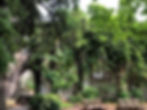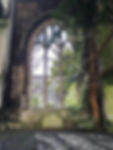Visiting St. Dunstan in the East
4 min readSt. Dunstan in the East is often touted to visitors as a 'Secret Garden', where the bombed out ruins of a church hide a garden filled...
St. Dunstan in the East is often touted to visitors as a ‘Secret Garden’, where the bombed out ruins of a church hide a garden filled with plants to create a beautiful quiet spot away from the crowds. The truth is somewhat different as it features in so many photoshoots and Instagram photos that it is actually a well known location. That aside, it is still a fascinating place and well worth a visit if you are in the area, for that small spot near the Thames encapsulates much of London’s history.

Wreathed in ivy and lush greenery, the ruins of the church of St. Dunstan in the East are a peaceful enclave away from the chaos and intensity of the banking institutions that surround it. A shell of a church with blackened walls, no ceiling and empty Gothic windows; all that remains intact is a bell tower designed by Christopher Wren. These ruins are Grade I listed and serve as a bleak yet beautiful reminder of the damage that has been inflicted on the city over the centuries.
St. Dunstan’s was a parish church built around 1100 AD near the Tower of London and River Thames. The church was named for Saint Dunstan, a 10th century monk born in 909 who spent much of his early life being taught by Irish monks in Glastonbury Abbey. He survived several illnesses including a near fatal childhood illness and being thrown in a cesspool where he contracted blood poisoning and ended up covered in tumours.

He spent time in the courts of several Saxon kings, each time being falsely accused by jealous courtiers of involvement with black magic and the Devil. He was well known as a skilled musician and metal worker, and eventually, after many trials and tribulations, became the Archbishop of Canterbury.
Dunstan was canonised in 1029 and was the favourite saint of the English until Thomas a Becket usurped his popularity. He had founded (or rebuilt) Stepneys church in 952 A.D. which was originally dedicated to All Saints, but rededicated to him after his canonisation, which is the church now known as St Dunstan in the West.
The ruins you see are not the original 1000 year old building – it has been added to, replaced and repaired over the years, particularly in the 14th century. Three hundred years later the Great Fire of London in 1666 inflicted some serious damage – Pudding Lane where the fire started is a minute’s walk away so it was in the thick of the fiery onslaught. It was patched up in the following years with a new tower added in 1668 as part of Christopher Wren’s massive undertaking to rebuild the churches of London, and the steeple was added in 1701. The tower and steeple kept the Gothic style so that they blended in with the body of the church, there were carvings by famous sculptor Greenling Gibbons who also worked on the rebuild of St Paul’s Cathedral, and an organ which is now at the abbey in St Albans.
In the 19th century there were problems with the roof. The architects were going to rebuild just the roof but the church was in such bad condition that the whole building was taken down and built again, although the original tower was retained. It reopened in 1821. Built of Portland stone, it could accommodate up to 700 people and thrived as a parish church.
Over 100 years later, 1941 saw the peak of the Blitz, a massive German bombing campaign that dropped 30,000 tonnes of high explosive over the UK, a large amount of which was over London. Much of the East End was destroyed, including this once proud parish church which was decimated, although the tower and north and south walls remained standing.

Being too costly to repair, the Gothic ruins were turned into a public botanical garden in the 1960s, which opened to the public in 1971. Since then it has been a place of peace and refuge as the City of London grew around it, giving a small oasis of green amongst all the concrete and chrome.

With a small lawn, mature trees including palm trees which lend a tropical air, an old sundial clock, a fountain in the middle which was built on top of the nave and encircled by benches, it is a beautiful spot for the city workers to enjoy in the summer, and for visitors to use for atmospheric photos. Any visit you make will inevitably see you watching women in flowing dresses posing in front of the arched windows and glancing coquettishly at the camera.
The ruins are free to visit and are a delightful place to rest on one of the benches and watch the world go by. It is a great place to really spark the imagination, with its mysterious dark walls and empty windows, and is one of the few places left that people can get a glimpse of the damage caused by the Blitz in London, under the shadow or Wren’s tower from that other period of mass destruction some 400 years earlier.
The church is no longer in use as the parish was combined with nearby All Hallows by the Tower, but they do have occasional services there. The Wren tower is closed to the public as it is used for the All Hallows House Foundation which is a charity for health services.
Visiting St. Dunstan in the East
Opening Hours: 8am – dusk or 7pm, whichever is earlier
The site is sometimes closed to the public for private functions.
Ticket Prices: Entry is free
How to get there: The nearest tube stations are Monument or Tower Hill.


